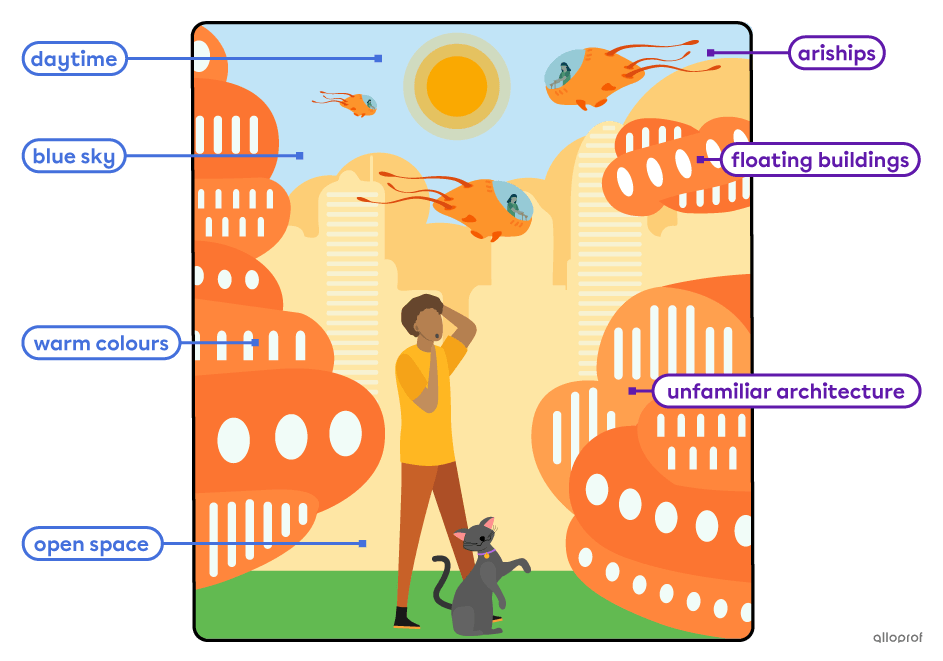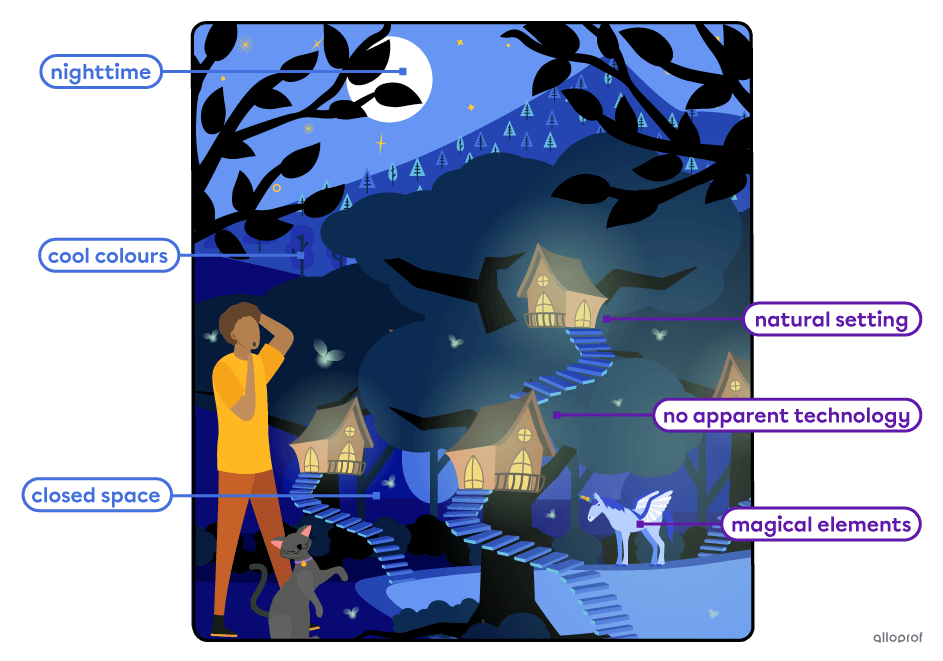Inferring is reading between the lines.
| When to do it |
| While reading the text |
| After reading the text |
| Reading intention |
| Find deeper meaning |
| Find additional information |
| Draw conclusions |
| Outcome |
| Better understanding |
| Author's intent & stance |
| Identifying themes |
| Insight into the text’s message |
How to Do It
-
Look for clues
-
Connect the dots
-
Draw conclusions
Authors leave clues in their writings, some intentionally and some unintentionally. These clues point to their intent, their message, their stance and even to real world elements around them.
Clues can be found almost anywhere in a text.
Text elements that often contain clues are:
Looking at the choice of words and the phrasing of a sentence can reveal layers of implied meaning.
| Example A | |
| Look for clues | “What a big cat!” thought Jim. |
| Connect the dots | Word choice: big → Describes the cat’s size with basic vocabulary |
| Punctuation: exclamation mark → Expresses surprise | |
| Draw conclusions | The cat is a regular cat that is larger than what the character is used to. |
| Example B | |
| Look for clues | “What a huge cat!” thought Jim → Describes the cat’s size with richer vocabulary |
| Connect the dots | Word choice: huge → Implies the cat is bigger than just the adjective big |
| Punctuation: exclamation mark → Expresses surprise | |
| Draw conclusions | The cat is a regular cat, but is much larger than what the character is used to. Possibly one of the largest he has ever seen. |
| Example C | |
| Look for clues | “That’s a really, really big cat,” thought Jim, “Really big.” |
| Connect the dots | Word choice: really (adverb) + big (adjective) → Describes the cat’s size → Implies the cat is bigger than just the adjective big |
| Phrasing: repetition → Implies the character talking is surprised by the size of the cat | |
| Draw conclusions | The size of the cat is unsettling to the character. This is not just a cat. Something else is going on. |
Paying attention to what characters do and say can point to implied development, story themes, plot points, foreshadowing and so on.
| Example A | |
| Look for clues | The cat stretched, jumped down and walked. “Hello, Jim. How do you do,” he then added. |
| Connect the dots | Greetings → The cat knows and was expecting Jim. → They are meeting for the first time (“how do you do”). → The cat can talk. |
| Tone → Friendly | |
| Draw conclusions | This cat is special: it can talk. The cat knowing Jim implies it has more knowledge than Jim. |
| The cat could be an ally or setting a trap or Jim. | |
| Example B | |
| Look for clues | The cat stretched, then started licking its paw. “You are late,” he said without looking at Jim, still invested in cleaning its paw. |
| Connect the dots | Greetings → The cat was expecting Jim (“you are late”). → The cat is annoyed/impatient. |
| Tone → Annoyed/impatient | |
| Draw conclusions | This cat is special: it can talk. The cat knowing Jim implies it has more knowledge than Jim. |
| The cat wants Jim to feel his annoyance/impatience (licking his paw, intentionally not making eye contact) | |
Looking at how text elements are organized can give insight into the author’s intentions.
| Example A | |
| Look for clues | The cat cleared its throat and said: “Such magnificence likely unattainable for, a cat you aren't.” |
| Connect the dots | Poem → haiku format |
| Meaning: expresses that cats are better. | |
| Draw conclusions | The character using a haiku poem suggests the character’s knowledge and sophistication, most likely a little superiority complex too. |
| Example B | |
| Look for clues | The cat cleared its throat and recited: “kingdom: Animalia phylum: Chordata class: Mammalia order: Carnivora family: Felidae species: Felis catus common name: cat.” |
| Connect the dots | Informational text → animal classification |
| Meaning: provide specific information on the animal classification of the cat. | |
| Draw conclusions | The character reciting the animal classification with Latin words suggests encyclopedic knowledge. It is likely the character has a vast array of facts memorized. It is also likely the character likes to show it off. |
Looking at where and when a story takes place will provide extra information and context for the storytelling.
| Example A | |
| Look for clues |  |
| Connect the dots | Comfortable and welcoming |
| Set in the future | |
| Active and lively | |
| Draw conclusions | The author likely wants the reader to feel at ease. There is an effort to establishing a sense of wonder and hope. |
| Unknown technology presented as everyday life is likely to present challenges for the main character. | |
| It could be a used for: → conflict—man vs. machine → comedy—fish out of water → plot device—MacGuffin (an object driving the plot) | |
| Example B | |
| Look for clues |  |
| Connect the dots | Sets a creepy mood Feels unfamiliar & uncomfortable Seems closed off from the rest of the world |
| Looks like a primitive world, maybe set in the past | |
| Magic elements provide a source of power, conflict, technology stand-in | |
| Draw conclusions | The author likely wants to destabilize the readers, wanting them to expect something bad to happen. |
| The author uses the tropes of the primitive magical world for the reader to quickly understand the surroundings. | |
To learn more about a strategy, click its name.
|
Get an overview of the text. |
Quickly search & find information |
Ask yourself questions |
|
Inferring |
||
|
Create mental pictures |
Relate to the text |
Read between the lines |
|
Write down notes & comments |
Understand challenging words |
Sum up main idea & key elements |
|
Explore sources to come up with new perspectives |
Form an opinion on the quality of the text |
Look at the structure and techniques used |